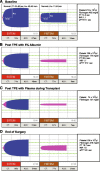Therapeutic plasma exchange in heart transplantation: role of coagulation assessment with thromboelastometry
- PMID: 29492426
- PMCID: PMC5814793
- DOI: 10.1186/s40981-016-0058-1
Therapeutic plasma exchange in heart transplantation: role of coagulation assessment with thromboelastometry
Abstract
Therapeutic plasma exchange (TPE) is a potentially life-saving procedure which effectively removes donor-specific human leukocyte antigen (HLA) antibodies from the bloodstream, allowing critically ill heart transplant recipients to receive a donor organ with less wait time, and reducing the risk of acute organ rejection. The bulk of coagulation factors is initially removed from the blood during TPE using albumin and is later replaced with allogeneic plasma. Coagulopathy may develop during TPE and then can persist due to intraoperative blood loss and hemodilution during surgery and cardiopulmonary bypass. We hereby describe the utility of rotational thromboelastometry to assess rapid coagulation changes during TPE and subsequent heart transplant (HT) surgery.
Keywords: Coagulation; Coagulation factor deficiency; Fresh frozen plasma; Heart transplantation; Plasma exchange.
Figures

References
-
- Winters JL. Plasma exchange: concepts, mechanisms, and an overview of the American Society for Apheresis guidelines. Hematology. 2012;2012:7–12. - PubMed
LinkOut - more resources
Full Text Sources
Other Literature Sources
Research Materials
